Report on Accounting and Finance: APN Outdoor Group Analysis
VerifiedAdded on 2020/03/28
|9
|1396
|78
Report
AI Summary
This report provides a comprehensive analysis of APN Outdoor's capital structure, focusing on its debt and equity composition. It computes the company's Weighted Average Cost of Capital (WACC) and evaluates key financial ratios, including earnings per share, price-earnings ratio, and liquidity ratios such as cash, quick, and current ratios. The report compares APN Outdoor's capital structure to that of its competitor, Ooh Media, highlighting similarities and differences in their financing approaches. It also examines the impact of capital structure changes on the company's cost of capital and overall financial performance, concluding with an assessment of APN Outdoor's dividend payouts and shareholder returns. The report utilizes various financial metrics and ratios to assess APN Outdoor's financial health and investment potential.
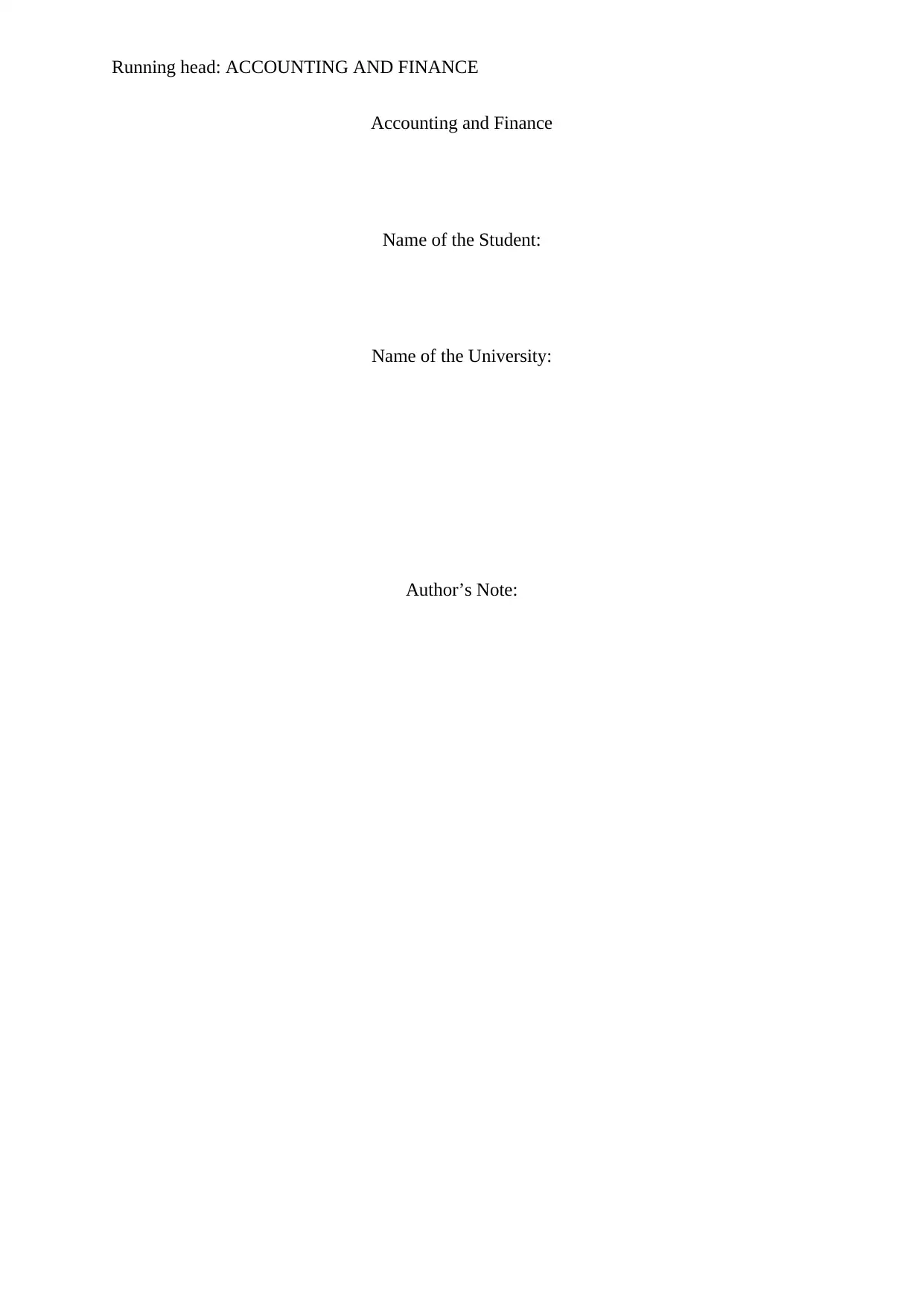
Running head: ACCOUNTING AND FINANCE
Accounting and Finance
Name of the Student:
Name of the University:
Author’s Note:
Accounting and Finance
Name of the Student:
Name of the University:
Author’s Note:
Paraphrase This Document
Need a fresh take? Get an instant paraphrase of this document with our AI Paraphraser
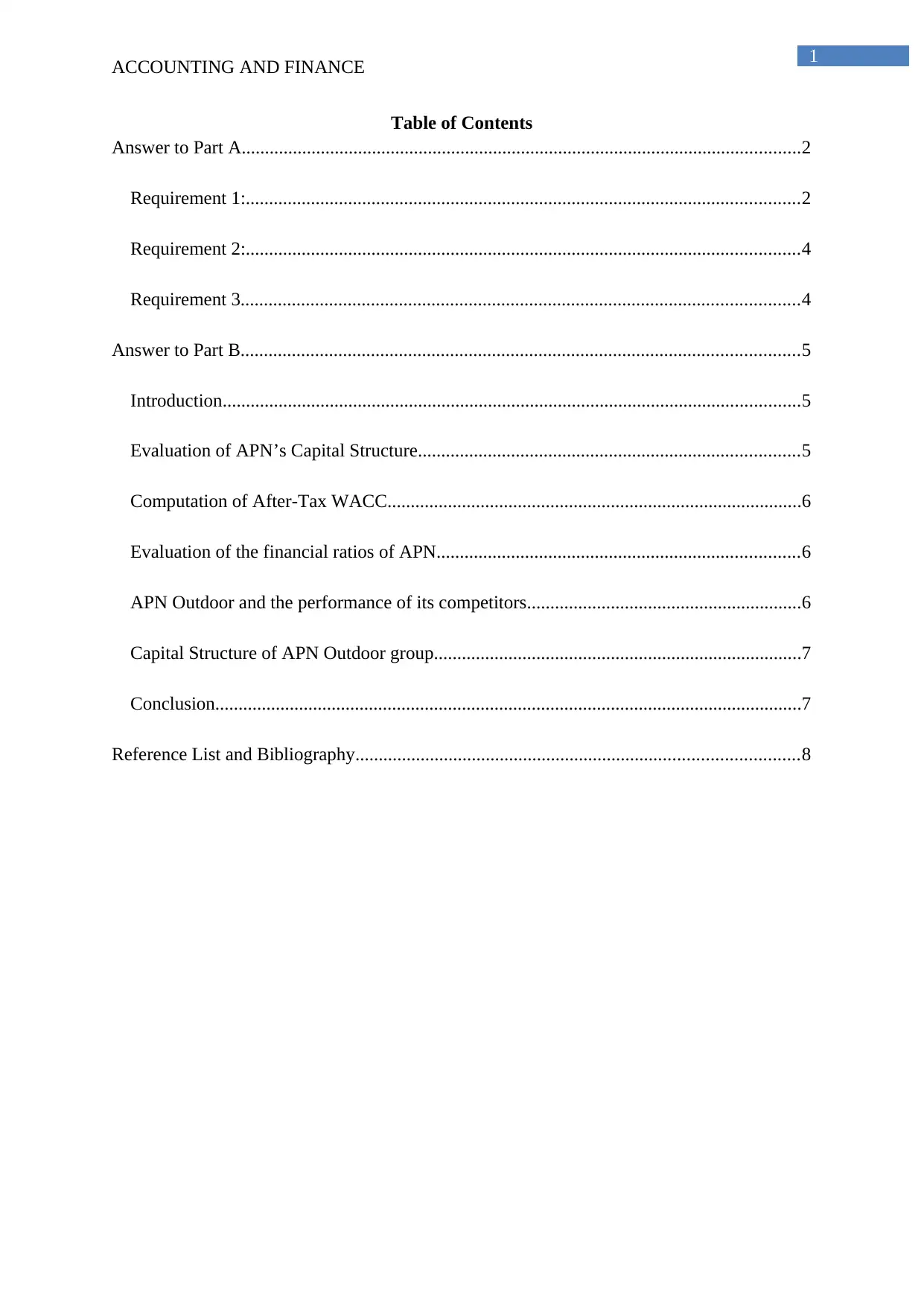
1
ACCOUNTING AND FINANCE
Table of Contents
Answer to Part A........................................................................................................................2
Requirement 1:.......................................................................................................................2
Requirement 2:.......................................................................................................................4
Requirement 3........................................................................................................................4
Answer to Part B........................................................................................................................5
Introduction............................................................................................................................5
Evaluation of APN’s Capital Structure..................................................................................5
Computation of After-Tax WACC.........................................................................................6
Evaluation of the financial ratios of APN..............................................................................6
APN Outdoor and the performance of its competitors...........................................................6
Capital Structure of APN Outdoor group...............................................................................7
Conclusion..............................................................................................................................7
Reference List and Bibliography...............................................................................................8
ACCOUNTING AND FINANCE
Table of Contents
Answer to Part A........................................................................................................................2
Requirement 1:.......................................................................................................................2
Requirement 2:.......................................................................................................................4
Requirement 3........................................................................................................................4
Answer to Part B........................................................................................................................5
Introduction............................................................................................................................5
Evaluation of APN’s Capital Structure..................................................................................5
Computation of After-Tax WACC.........................................................................................6
Evaluation of the financial ratios of APN..............................................................................6
APN Outdoor and the performance of its competitors...........................................................6
Capital Structure of APN Outdoor group...............................................................................7
Conclusion..............................................................................................................................7
Reference List and Bibliography...............................................................................................8

2
ACCOUNTING AND FINANCE
Answer to Part A
Requirement 1:
Particulars 0 1 2 3 4 5 6 7 8
Initial Investment ($1,650,000)
Annual Cash Flow:
Incremental Revene $1,445,000 $1,589,500 $1,748,450 $1,923,295 $2,115,625 $2,327,187 $2,559,906 $2,815,896
Staff Cost ($900,000) ($954,000) ($1,011,240) ($1,071,914) ($1,136,229) ($1,204,403) ($1,276,667) ($1,353,267)
Material Costs ($210,000) ($222,600) ($235,956) ($250,113) ($265,120) ($281,027) ($297,889) ($315,762)
Marketing Costs ($46,000) ($48,760) ($51,686) ($54,787) ($58,074) ($61,558) ($65,252) ($69,167)
Other Costs ($25,000) ($26,500) ($28,090) ($29,775) ($31,562) ($33,456) ($35,463) ($37,591)
Depreciation of Lab ($206,250) ($206,250) ($206,250) ($206,250) ($206,250) ($206,250) ($206,250) ($206,250)
Net Profit before Tax $57,750 $131,390 $215,228 $310,455 $418,389 $540,493 $678,385 $833,859
Less: Tax on Profit ($17,325) ($39,417) ($64,569) ($93,137) ($125,517) ($162,148) ($203,515) ($250,158)
Net Profit after Tax $40,425 $91,973 $150,660 $217,319 $292,872 $378,345 $474,869 $583,701
Add: Depreciation $206,250 $206,250 $206,250 $206,250 $206,250 $206,250 $206,250 $206,250
Annual After-Tax Cash Flow $246,675 $298,223 $356,910 $423,569 $499,122 $584,595 $681,119 $789,951
Salvage Value $100,000
Net Annual Cash Flow ($1,650,000) $246,675 $298,223 $356,910 $423,569 $499,122 $584,595 $681,119 $889,951
Cumulative Cash Flow ($1,650,000) ($1,403,325) ($1,105,102) ($748,192) ($324,624) $174,499 $759,094 $1,440,213 $2,330,164
Payback Period
Required Rate of Return 16% 16% 16% 16% 16% 16% 16% 16% 16%
Discounted Cash Flow ($1,650,000) $212,651 $221,628 $228,657 $233,933 $237,639 $239,942 $241,000 $271,458
Cumulative Discounted Cash Flow ($1,650,000) ($1,437,349) ($1,215,721) ($987,064) ($753,131) ($515,492) ($275,550) ($34,549) $236,908
Discounted Payback period
Net Present Value
Profitability Index
4.65
7.13
$236,908
114.36%
Period
Capital Budgeting for Base-Case:
ACCOUNTING AND FINANCE
Answer to Part A
Requirement 1:
Particulars 0 1 2 3 4 5 6 7 8
Initial Investment ($1,650,000)
Annual Cash Flow:
Incremental Revene $1,445,000 $1,589,500 $1,748,450 $1,923,295 $2,115,625 $2,327,187 $2,559,906 $2,815,896
Staff Cost ($900,000) ($954,000) ($1,011,240) ($1,071,914) ($1,136,229) ($1,204,403) ($1,276,667) ($1,353,267)
Material Costs ($210,000) ($222,600) ($235,956) ($250,113) ($265,120) ($281,027) ($297,889) ($315,762)
Marketing Costs ($46,000) ($48,760) ($51,686) ($54,787) ($58,074) ($61,558) ($65,252) ($69,167)
Other Costs ($25,000) ($26,500) ($28,090) ($29,775) ($31,562) ($33,456) ($35,463) ($37,591)
Depreciation of Lab ($206,250) ($206,250) ($206,250) ($206,250) ($206,250) ($206,250) ($206,250) ($206,250)
Net Profit before Tax $57,750 $131,390 $215,228 $310,455 $418,389 $540,493 $678,385 $833,859
Less: Tax on Profit ($17,325) ($39,417) ($64,569) ($93,137) ($125,517) ($162,148) ($203,515) ($250,158)
Net Profit after Tax $40,425 $91,973 $150,660 $217,319 $292,872 $378,345 $474,869 $583,701
Add: Depreciation $206,250 $206,250 $206,250 $206,250 $206,250 $206,250 $206,250 $206,250
Annual After-Tax Cash Flow $246,675 $298,223 $356,910 $423,569 $499,122 $584,595 $681,119 $789,951
Salvage Value $100,000
Net Annual Cash Flow ($1,650,000) $246,675 $298,223 $356,910 $423,569 $499,122 $584,595 $681,119 $889,951
Cumulative Cash Flow ($1,650,000) ($1,403,325) ($1,105,102) ($748,192) ($324,624) $174,499 $759,094 $1,440,213 $2,330,164
Payback Period
Required Rate of Return 16% 16% 16% 16% 16% 16% 16% 16% 16%
Discounted Cash Flow ($1,650,000) $212,651 $221,628 $228,657 $233,933 $237,639 $239,942 $241,000 $271,458
Cumulative Discounted Cash Flow ($1,650,000) ($1,437,349) ($1,215,721) ($987,064) ($753,131) ($515,492) ($275,550) ($34,549) $236,908
Discounted Payback period
Net Present Value
Profitability Index
4.65
7.13
$236,908
114.36%
Period
Capital Budgeting for Base-Case:
⊘ This is a preview!⊘
Do you want full access?
Subscribe today to unlock all pages.

Trusted by 1+ million students worldwide
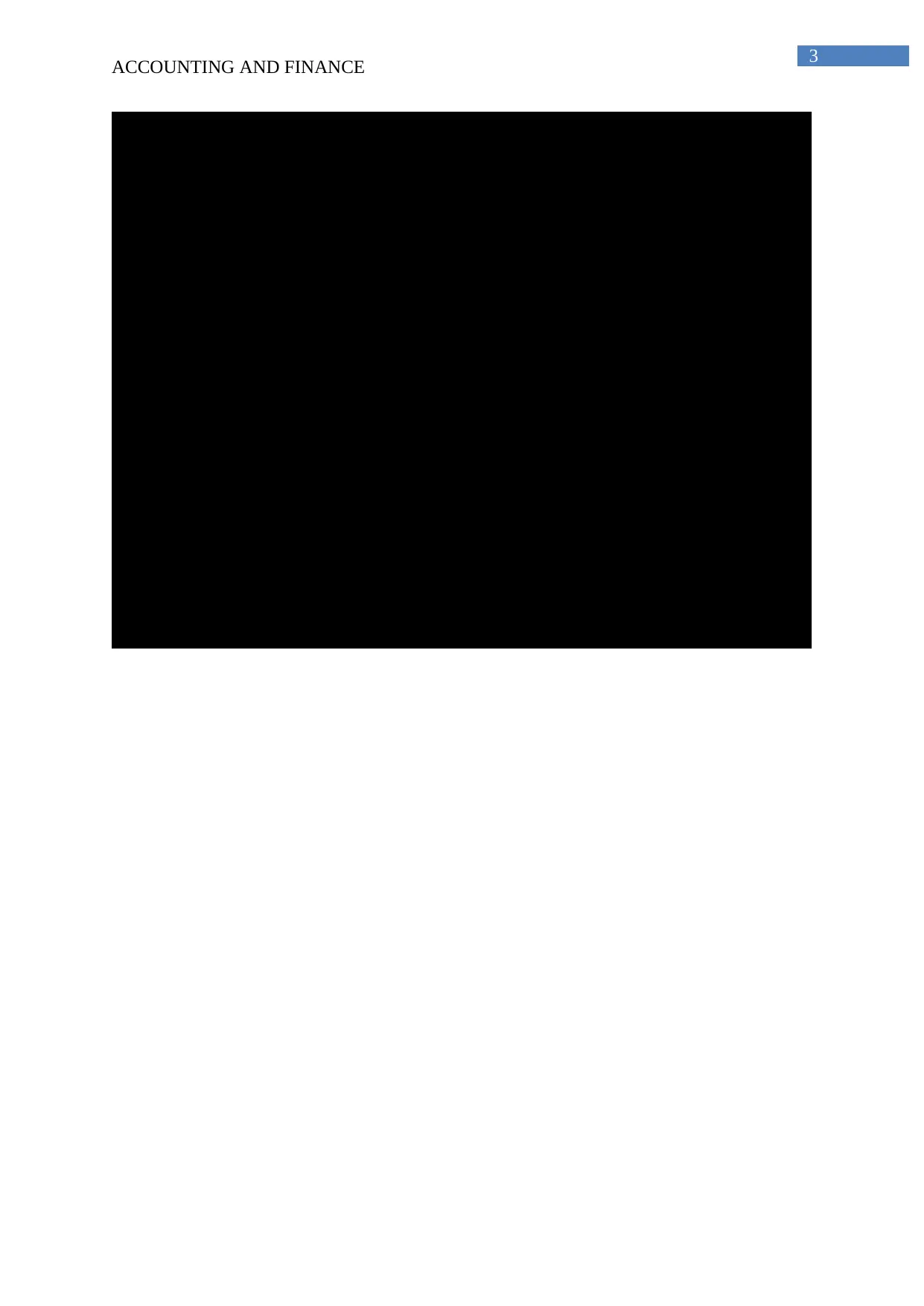
3
ACCOUNTING AND FINANCE
Particulars 0 1 2 3 4 5 6 7 8
Initial Investment ($1,650,000)
Annual Cash Flow:
Incremental Revene $1,445,000 $1,531,700 $1,623,602 $1,721,018 $1,824,279 $1,933,736 $2,049,760 $2,172,746
Staff Cost ($900,000) ($990,000) ($1,089,000) ($1,197,900) ($1,317,690) ($1,449,459) ($1,594,405) ($1,753,845)
Material Costs ($210,000) ($231,000) ($254,100) ($279,510) ($307,461) ($338,207) ($372,028) ($409,231)
Marketing Costs ($46,000) ($50,600) ($55,660) ($61,226) ($67,349) ($74,083) ($81,492) ($89,641)
Other Costs ($25,000) ($27,500) ($30,250) ($33,275) ($36,603) ($40,263) ($44,289) ($48,718)
Depreciation of Lab ($206,250) ($206,250) ($206,250) ($206,250) ($206,250) ($206,250) ($206,250) ($206,250)
Net Profit before Tax $57,750 $26,350 ($11,658) ($57,143) ($111,073) ($174,526) ($248,703) ($334,939)
Less: Tax on Profit ($17,325) ($7,905) $3,497 $17,143 $33,322 $52,358 $74,611 $100,482
Net Profit after Tax $40,425 $18,445 ($8,161) ($40,000) ($77,751) ($122,168) ($174,092) ($234,457)
Add: Depreciation $206,250 $206,250 $206,250 $206,250 $206,250 $206,250 $206,250 $206,250
Annual After-Tax Cash Flow $246,675 $224,695 $198,089 $166,250 $128,499 $84,082 $32,158 ($28,207)
Salvage Value $100,000
Net Annual Cash Flow ($1,650,000) $246,675 $224,695 $198,089 $166,250 $128,499 $84,082 $32,158 $71,793
Cumulative Cash Flow ($1,650,000) ($1,403,325) ($1,178,630) ($980,541) ($814,291) ($685,792) ($601,710) ($569,552) ($497,760)
Payback Period
Required Rate of Return 16% 16% 16% 16% 16% 16% 16% 16% 16%
Discounted Cash Flow ($1,650,000) $212,651 $166,985 $126,907 $91,818 $61,180 $34,511 $11,378 $21,899
Cumulative Discounted Cash Flow ($1,650,000) ($1,437,349) ($1,270,364) ($1,143,457) ($1,051,638) ($990,458) ($955,948) ($944,569) ($922,671)
Discounted Payback period
Net Present Value
Profitability Index
Capital Budgeting for Worst-Case:
Period
10.34
50.13
($922,671)
44.08%
ACCOUNTING AND FINANCE
Particulars 0 1 2 3 4 5 6 7 8
Initial Investment ($1,650,000)
Annual Cash Flow:
Incremental Revene $1,445,000 $1,531,700 $1,623,602 $1,721,018 $1,824,279 $1,933,736 $2,049,760 $2,172,746
Staff Cost ($900,000) ($990,000) ($1,089,000) ($1,197,900) ($1,317,690) ($1,449,459) ($1,594,405) ($1,753,845)
Material Costs ($210,000) ($231,000) ($254,100) ($279,510) ($307,461) ($338,207) ($372,028) ($409,231)
Marketing Costs ($46,000) ($50,600) ($55,660) ($61,226) ($67,349) ($74,083) ($81,492) ($89,641)
Other Costs ($25,000) ($27,500) ($30,250) ($33,275) ($36,603) ($40,263) ($44,289) ($48,718)
Depreciation of Lab ($206,250) ($206,250) ($206,250) ($206,250) ($206,250) ($206,250) ($206,250) ($206,250)
Net Profit before Tax $57,750 $26,350 ($11,658) ($57,143) ($111,073) ($174,526) ($248,703) ($334,939)
Less: Tax on Profit ($17,325) ($7,905) $3,497 $17,143 $33,322 $52,358 $74,611 $100,482
Net Profit after Tax $40,425 $18,445 ($8,161) ($40,000) ($77,751) ($122,168) ($174,092) ($234,457)
Add: Depreciation $206,250 $206,250 $206,250 $206,250 $206,250 $206,250 $206,250 $206,250
Annual After-Tax Cash Flow $246,675 $224,695 $198,089 $166,250 $128,499 $84,082 $32,158 ($28,207)
Salvage Value $100,000
Net Annual Cash Flow ($1,650,000) $246,675 $224,695 $198,089 $166,250 $128,499 $84,082 $32,158 $71,793
Cumulative Cash Flow ($1,650,000) ($1,403,325) ($1,178,630) ($980,541) ($814,291) ($685,792) ($601,710) ($569,552) ($497,760)
Payback Period
Required Rate of Return 16% 16% 16% 16% 16% 16% 16% 16% 16%
Discounted Cash Flow ($1,650,000) $212,651 $166,985 $126,907 $91,818 $61,180 $34,511 $11,378 $21,899
Cumulative Discounted Cash Flow ($1,650,000) ($1,437,349) ($1,270,364) ($1,143,457) ($1,051,638) ($990,458) ($955,948) ($944,569) ($922,671)
Discounted Payback period
Net Present Value
Profitability Index
Capital Budgeting for Worst-Case:
Period
10.34
50.13
($922,671)
44.08%
Paraphrase This Document
Need a fresh take? Get an instant paraphrase of this document with our AI Paraphraser
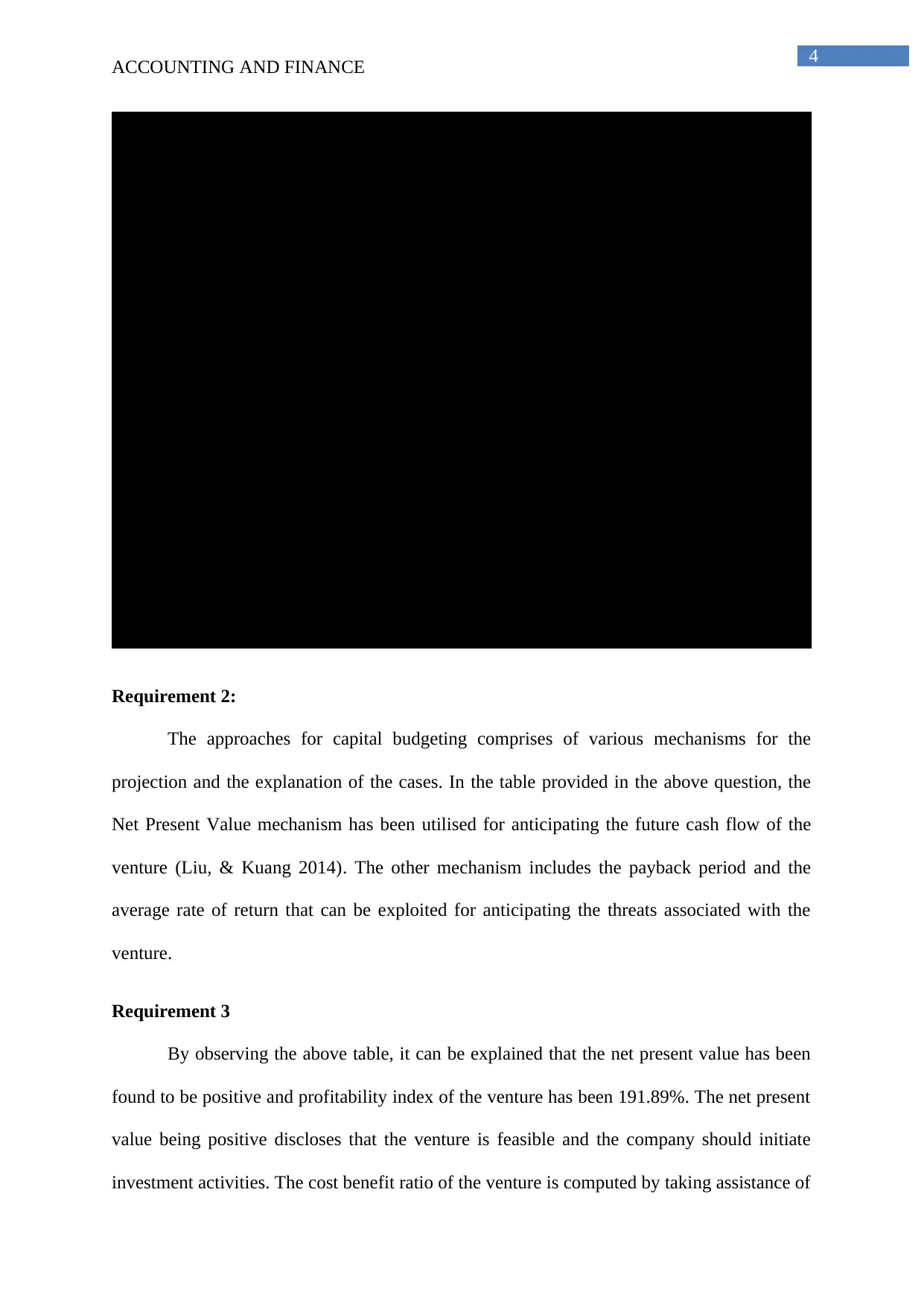
4
ACCOUNTING AND FINANCE
Particulars 0 1 2 3 4 5 6 7 8
Initial Investment ($1,650,000)
Annual Cash Flow:
Incremental Revene $1,445,000 $1,661,750 $1,911,013 $2,197,664 $2,527,314 $2,906,411 $3,342,373 $3,843,729
Staff Cost ($900,000) ($927,000) ($954,810) ($983,454) ($1,012,958) ($1,043,347) ($1,074,647) ($1,106,886)
Material Costs ($210,000) ($216,300) ($222,789) ($229,473) ($236,357) ($243,448) ($250,751) ($258,274)
Marketing Costs ($46,000) ($47,380) ($48,801) ($50,265) ($51,773) ($53,327) ($54,926) ($56,574)
Other Costs ($25,000) ($25,750) ($26,523) ($27,318) ($28,138) ($28,982) ($29,851) ($30,747)
Depreciation of Lab ($206,250) ($206,250) ($206,250) ($206,250) ($206,250) ($206,250) ($206,250) ($206,250)
Net Profit before Tax $57,750 $239,070 $451,840 $700,904 $991,838 $1,331,058 $1,725,947 $2,184,998
Less: Tax on Profit ($17,325) ($71,721) ($135,552) ($210,271) ($297,551) ($399,318) ($517,784) ($655,499)
Net Profit after Tax $40,425 $167,349 $316,288 $490,633 $694,287 $931,741 $1,208,163 $1,529,498
Add: Depreciation $206,250 $206,250 $206,250 $206,250 $206,250 $206,250 $206,250 $206,250
Annual After-Tax Cash Flow $246,675 $373,599 $522,538 $696,883 $900,537 $1,137,991 $1,414,413 $1,735,748
Salvage Value $100,000
Net Annual Cash Flow ($1,650,000) $246,675 $373,599 $522,538 $696,883 $900,537 $1,137,991 $1,414,413 $1,835,748
Cumulative Cash Flow ($1,650,000) ($1,403,325) ($1,029,726) ($507,188) $189,694 $1,090,231 $2,228,222 $3,642,635 $5,478,383
Payback Period
Required Rate of Return 16% 16% 16% 16% 16% 16% 16% 16% 16%
Discounted Cash Flow ($1,650,000) $212,651 $277,645 $334,768 $384,882 $428,757 $467,080 $500,461 $559,950
Cumulative Discounted Cash Flow ($1,650,000) ($1,437,349) ($1,159,704) ($824,936) ($440,054) ($11,297) $455,782 $956,244 $1,516,194
Discounted Payback period
Net Present Value
Profitability Index
Capital Budgeting for Best-Case:
Period
3.79
5.29
$1,516,194
191.89%
Requirement 2:
The approaches for capital budgeting comprises of various mechanisms for the
projection and the explanation of the cases. In the table provided in the above question, the
Net Present Value mechanism has been utilised for anticipating the future cash flow of the
venture (Liu, & Kuang 2014). The other mechanism includes the payback period and the
average rate of return that can be exploited for anticipating the threats associated with the
venture.
Requirement 3
By observing the above table, it can be explained that the net present value has been
found to be positive and profitability index of the venture has been 191.89%. The net present
value being positive discloses that the venture is feasible and the company should initiate
investment activities. The cost benefit ratio of the venture is computed by taking assistance of
ACCOUNTING AND FINANCE
Particulars 0 1 2 3 4 5 6 7 8
Initial Investment ($1,650,000)
Annual Cash Flow:
Incremental Revene $1,445,000 $1,661,750 $1,911,013 $2,197,664 $2,527,314 $2,906,411 $3,342,373 $3,843,729
Staff Cost ($900,000) ($927,000) ($954,810) ($983,454) ($1,012,958) ($1,043,347) ($1,074,647) ($1,106,886)
Material Costs ($210,000) ($216,300) ($222,789) ($229,473) ($236,357) ($243,448) ($250,751) ($258,274)
Marketing Costs ($46,000) ($47,380) ($48,801) ($50,265) ($51,773) ($53,327) ($54,926) ($56,574)
Other Costs ($25,000) ($25,750) ($26,523) ($27,318) ($28,138) ($28,982) ($29,851) ($30,747)
Depreciation of Lab ($206,250) ($206,250) ($206,250) ($206,250) ($206,250) ($206,250) ($206,250) ($206,250)
Net Profit before Tax $57,750 $239,070 $451,840 $700,904 $991,838 $1,331,058 $1,725,947 $2,184,998
Less: Tax on Profit ($17,325) ($71,721) ($135,552) ($210,271) ($297,551) ($399,318) ($517,784) ($655,499)
Net Profit after Tax $40,425 $167,349 $316,288 $490,633 $694,287 $931,741 $1,208,163 $1,529,498
Add: Depreciation $206,250 $206,250 $206,250 $206,250 $206,250 $206,250 $206,250 $206,250
Annual After-Tax Cash Flow $246,675 $373,599 $522,538 $696,883 $900,537 $1,137,991 $1,414,413 $1,735,748
Salvage Value $100,000
Net Annual Cash Flow ($1,650,000) $246,675 $373,599 $522,538 $696,883 $900,537 $1,137,991 $1,414,413 $1,835,748
Cumulative Cash Flow ($1,650,000) ($1,403,325) ($1,029,726) ($507,188) $189,694 $1,090,231 $2,228,222 $3,642,635 $5,478,383
Payback Period
Required Rate of Return 16% 16% 16% 16% 16% 16% 16% 16% 16%
Discounted Cash Flow ($1,650,000) $212,651 $277,645 $334,768 $384,882 $428,757 $467,080 $500,461 $559,950
Cumulative Discounted Cash Flow ($1,650,000) ($1,437,349) ($1,159,704) ($824,936) ($440,054) ($11,297) $455,782 $956,244 $1,516,194
Discounted Payback period
Net Present Value
Profitability Index
Capital Budgeting for Best-Case:
Period
3.79
5.29
$1,516,194
191.89%
Requirement 2:
The approaches for capital budgeting comprises of various mechanisms for the
projection and the explanation of the cases. In the table provided in the above question, the
Net Present Value mechanism has been utilised for anticipating the future cash flow of the
venture (Liu, & Kuang 2014). The other mechanism includes the payback period and the
average rate of return that can be exploited for anticipating the threats associated with the
venture.
Requirement 3
By observing the above table, it can be explained that the net present value has been
found to be positive and profitability index of the venture has been 191.89%. The net present
value being positive discloses that the venture is feasible and the company should initiate
investment activities. The cost benefit ratio of the venture is computed by taking assistance of
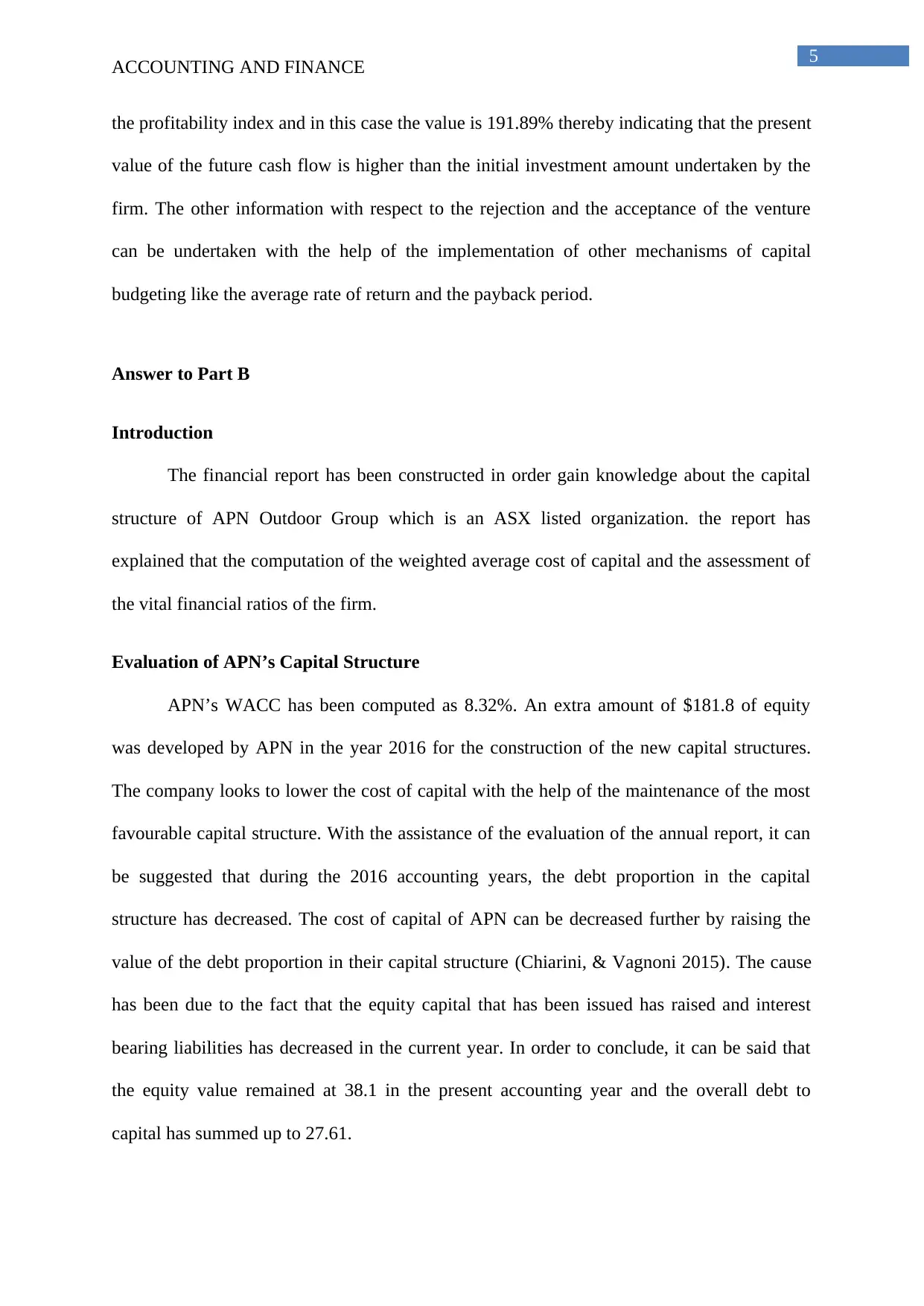
5
ACCOUNTING AND FINANCE
the profitability index and in this case the value is 191.89% thereby indicating that the present
value of the future cash flow is higher than the initial investment amount undertaken by the
firm. The other information with respect to the rejection and the acceptance of the venture
can be undertaken with the help of the implementation of other mechanisms of capital
budgeting like the average rate of return and the payback period.
Answer to Part B
Introduction
The financial report has been constructed in order gain knowledge about the capital
structure of APN Outdoor Group which is an ASX listed organization. the report has
explained that the computation of the weighted average cost of capital and the assessment of
the vital financial ratios of the firm.
Evaluation of APN’s Capital Structure
APN’s WACC has been computed as 8.32%. An extra amount of $181.8 of equity
was developed by APN in the year 2016 for the construction of the new capital structures.
The company looks to lower the cost of capital with the help of the maintenance of the most
favourable capital structure. With the assistance of the evaluation of the annual report, it can
be suggested that during the 2016 accounting years, the debt proportion in the capital
structure has decreased. The cost of capital of APN can be decreased further by raising the
value of the debt proportion in their capital structure (Chiarini, & Vagnoni 2015). The cause
has been due to the fact that the equity capital that has been issued has raised and interest
bearing liabilities has decreased in the current year. In order to conclude, it can be said that
the equity value remained at 38.1 in the present accounting year and the overall debt to
capital has summed up to 27.61.
ACCOUNTING AND FINANCE
the profitability index and in this case the value is 191.89% thereby indicating that the present
value of the future cash flow is higher than the initial investment amount undertaken by the
firm. The other information with respect to the rejection and the acceptance of the venture
can be undertaken with the help of the implementation of other mechanisms of capital
budgeting like the average rate of return and the payback period.
Answer to Part B
Introduction
The financial report has been constructed in order gain knowledge about the capital
structure of APN Outdoor Group which is an ASX listed organization. the report has
explained that the computation of the weighted average cost of capital and the assessment of
the vital financial ratios of the firm.
Evaluation of APN’s Capital Structure
APN’s WACC has been computed as 8.32%. An extra amount of $181.8 of equity
was developed by APN in the year 2016 for the construction of the new capital structures.
The company looks to lower the cost of capital with the help of the maintenance of the most
favourable capital structure. With the assistance of the evaluation of the annual report, it can
be suggested that during the 2016 accounting years, the debt proportion in the capital
structure has decreased. The cost of capital of APN can be decreased further by raising the
value of the debt proportion in their capital structure (Chiarini, & Vagnoni 2015). The cause
has been due to the fact that the equity capital that has been issued has raised and interest
bearing liabilities has decreased in the current year. In order to conclude, it can be said that
the equity value remained at 38.1 in the present accounting year and the overall debt to
capital has summed up to 27.61.
⊘ This is a preview!⊘
Do you want full access?
Subscribe today to unlock all pages.

Trusted by 1+ million students worldwide
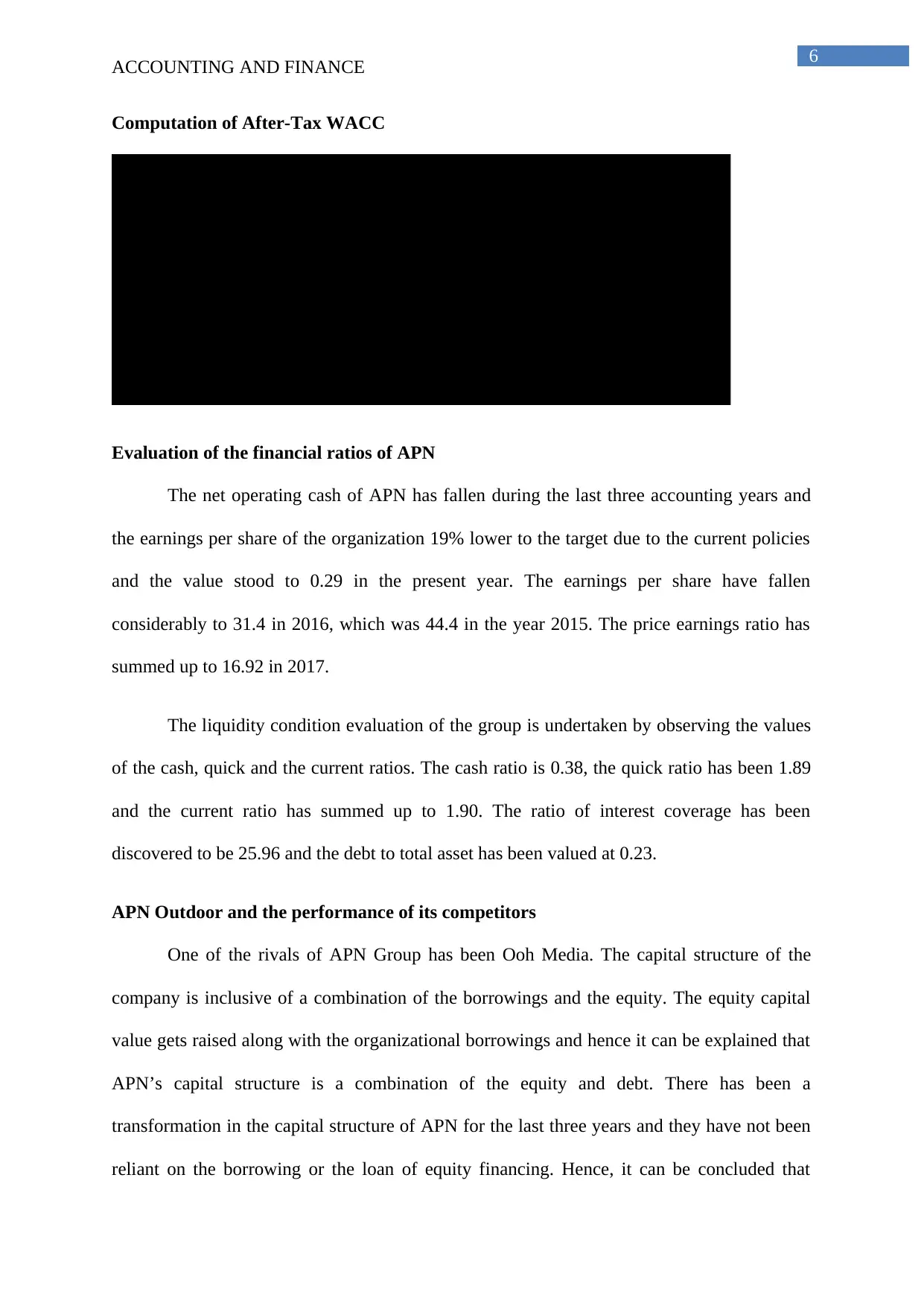
6
ACCOUNTING AND FINANCE
Computation of After-Tax WACC
Particulars Amount Weightage Return Rate
Weighted
Return
Total Equity Capital $836,465 83.83% 8.38% 7.03%
Total Debt Capital $161,309 16.17% 11.42% 1.85%
Tax Rate 30%
After-Tax Weighted Average Cost
of Capital 8.32%
Computation of After-Tax Weighted Avergae Cost of Capital:
Evaluation of the financial ratios of APN
The net operating cash of APN has fallen during the last three accounting years and
the earnings per share of the organization 19% lower to the target due to the current policies
and the value stood to 0.29 in the present year. The earnings per share have fallen
considerably to 31.4 in 2016, which was 44.4 in the year 2015. The price earnings ratio has
summed up to 16.92 in 2017.
The liquidity condition evaluation of the group is undertaken by observing the values
of the cash, quick and the current ratios. The cash ratio is 0.38, the quick ratio has been 1.89
and the current ratio has summed up to 1.90. The ratio of interest coverage has been
discovered to be 25.96 and the debt to total asset has been valued at 0.23.
APN Outdoor and the performance of its competitors
One of the rivals of APN Group has been Ooh Media. The capital structure of the
company is inclusive of a combination of the borrowings and the equity. The equity capital
value gets raised along with the organizational borrowings and hence it can be explained that
APN’s capital structure is a combination of the equity and debt. There has been a
transformation in the capital structure of APN for the last three years and they have not been
reliant on the borrowing or the loan of equity financing. Hence, it can be concluded that
ACCOUNTING AND FINANCE
Computation of After-Tax WACC
Particulars Amount Weightage Return Rate
Weighted
Return
Total Equity Capital $836,465 83.83% 8.38% 7.03%
Total Debt Capital $161,309 16.17% 11.42% 1.85%
Tax Rate 30%
After-Tax Weighted Average Cost
of Capital 8.32%
Computation of After-Tax Weighted Avergae Cost of Capital:
Evaluation of the financial ratios of APN
The net operating cash of APN has fallen during the last three accounting years and
the earnings per share of the organization 19% lower to the target due to the current policies
and the value stood to 0.29 in the present year. The earnings per share have fallen
considerably to 31.4 in 2016, which was 44.4 in the year 2015. The price earnings ratio has
summed up to 16.92 in 2017.
The liquidity condition evaluation of the group is undertaken by observing the values
of the cash, quick and the current ratios. The cash ratio is 0.38, the quick ratio has been 1.89
and the current ratio has summed up to 1.90. The ratio of interest coverage has been
discovered to be 25.96 and the debt to total asset has been valued at 0.23.
APN Outdoor and the performance of its competitors
One of the rivals of APN Group has been Ooh Media. The capital structure of the
company is inclusive of a combination of the borrowings and the equity. The equity capital
value gets raised along with the organizational borrowings and hence it can be explained that
APN’s capital structure is a combination of the equity and debt. There has been a
transformation in the capital structure of APN for the last three years and they have not been
reliant on the borrowing or the loan of equity financing. Hence, it can be concluded that
Paraphrase This Document
Need a fresh take? Get an instant paraphrase of this document with our AI Paraphraser
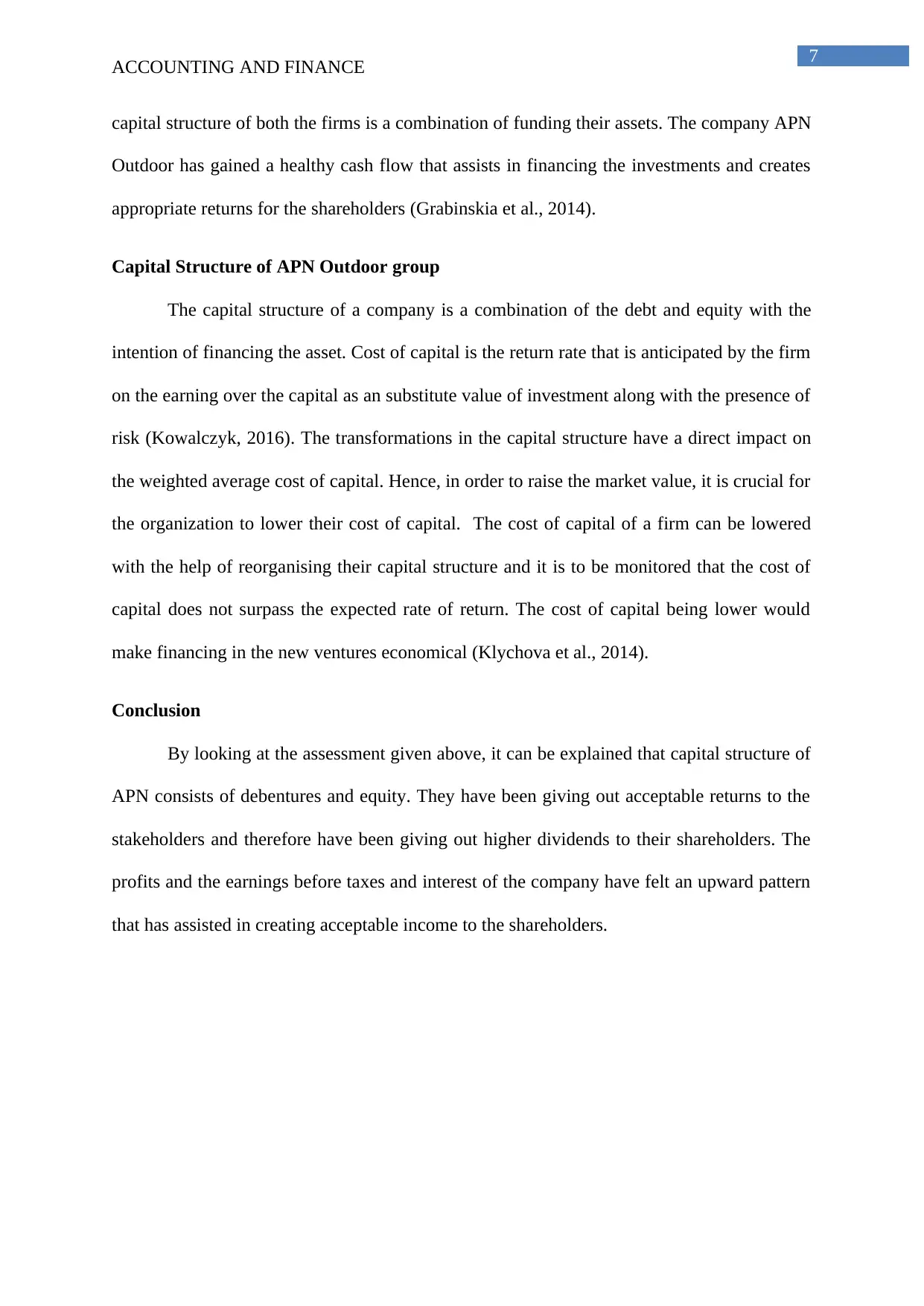
7
ACCOUNTING AND FINANCE
capital structure of both the firms is a combination of funding their assets. The company APN
Outdoor has gained a healthy cash flow that assists in financing the investments and creates
appropriate returns for the shareholders (Grabinskia et al., 2014).
Capital Structure of APN Outdoor group
The capital structure of a company is a combination of the debt and equity with the
intention of financing the asset. Cost of capital is the return rate that is anticipated by the firm
on the earning over the capital as an substitute value of investment along with the presence of
risk (Kowalczyk, 2016). The transformations in the capital structure have a direct impact on
the weighted average cost of capital. Hence, in order to raise the market value, it is crucial for
the organization to lower their cost of capital. The cost of capital of a firm can be lowered
with the help of reorganising their capital structure and it is to be monitored that the cost of
capital does not surpass the expected rate of return. The cost of capital being lower would
make financing in the new ventures economical (Klychova et al., 2014).
Conclusion
By looking at the assessment given above, it can be explained that capital structure of
APN consists of debentures and equity. They have been giving out acceptable returns to the
stakeholders and therefore have been giving out higher dividends to their shareholders. The
profits and the earnings before taxes and interest of the company have felt an upward pattern
that has assisted in creating acceptable income to the shareholders.
ACCOUNTING AND FINANCE
capital structure of both the firms is a combination of funding their assets. The company APN
Outdoor has gained a healthy cash flow that assists in financing the investments and creates
appropriate returns for the shareholders (Grabinskia et al., 2014).
Capital Structure of APN Outdoor group
The capital structure of a company is a combination of the debt and equity with the
intention of financing the asset. Cost of capital is the return rate that is anticipated by the firm
on the earning over the capital as an substitute value of investment along with the presence of
risk (Kowalczyk, 2016). The transformations in the capital structure have a direct impact on
the weighted average cost of capital. Hence, in order to raise the market value, it is crucial for
the organization to lower their cost of capital. The cost of capital of a firm can be lowered
with the help of reorganising their capital structure and it is to be monitored that the cost of
capital does not surpass the expected rate of return. The cost of capital being lower would
make financing in the new ventures economical (Klychova et al., 2014).
Conclusion
By looking at the assessment given above, it can be explained that capital structure of
APN consists of debentures and equity. They have been giving out acceptable returns to the
stakeholders and therefore have been giving out higher dividends to their shareholders. The
profits and the earnings before taxes and interest of the company have felt an upward pattern
that has assisted in creating acceptable income to the shareholders.
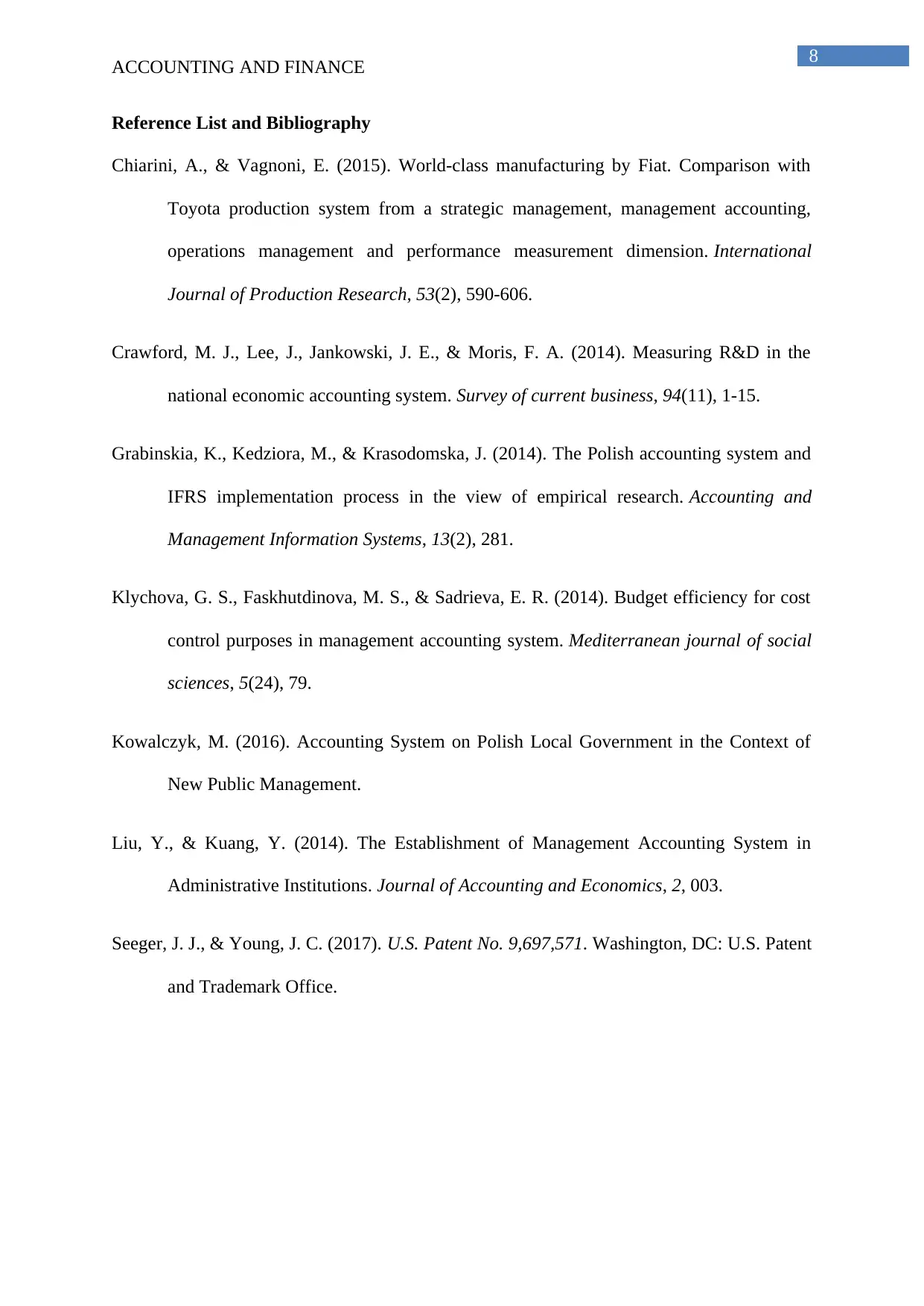
8
ACCOUNTING AND FINANCE
Reference List and Bibliography
Chiarini, A., & Vagnoni, E. (2015). World-class manufacturing by Fiat. Comparison with
Toyota production system from a strategic management, management accounting,
operations management and performance measurement dimension. International
Journal of Production Research, 53(2), 590-606.
Crawford, M. J., Lee, J., Jankowski, J. E., & Moris, F. A. (2014). Measuring R&D in the
national economic accounting system. Survey of current business, 94(11), 1-15.
Grabinskia, K., Kedziora, M., & Krasodomska, J. (2014). The Polish accounting system and
IFRS implementation process in the view of empirical research. Accounting and
Management Information Systems, 13(2), 281.
Klychova, G. S., Faskhutdinova, М. S., & Sadrieva, E. R. (2014). Budget efficiency for cost
control purposes in management accounting system. Mediterranean journal of social
sciences, 5(24), 79.
Kowalczyk, M. (2016). Accounting System on Polish Local Government in the Context of
New Public Management.
Liu, Y., & Kuang, Y. (2014). The Establishment of Management Accounting System in
Administrative Institutions. Journal of Accounting and Economics, 2, 003.
Seeger, J. J., & Young, J. C. (2017). U.S. Patent No. 9,697,571. Washington, DC: U.S. Patent
and Trademark Office.
ACCOUNTING AND FINANCE
Reference List and Bibliography
Chiarini, A., & Vagnoni, E. (2015). World-class manufacturing by Fiat. Comparison with
Toyota production system from a strategic management, management accounting,
operations management and performance measurement dimension. International
Journal of Production Research, 53(2), 590-606.
Crawford, M. J., Lee, J., Jankowski, J. E., & Moris, F. A. (2014). Measuring R&D in the
national economic accounting system. Survey of current business, 94(11), 1-15.
Grabinskia, K., Kedziora, M., & Krasodomska, J. (2014). The Polish accounting system and
IFRS implementation process in the view of empirical research. Accounting and
Management Information Systems, 13(2), 281.
Klychova, G. S., Faskhutdinova, М. S., & Sadrieva, E. R. (2014). Budget efficiency for cost
control purposes in management accounting system. Mediterranean journal of social
sciences, 5(24), 79.
Kowalczyk, M. (2016). Accounting System on Polish Local Government in the Context of
New Public Management.
Liu, Y., & Kuang, Y. (2014). The Establishment of Management Accounting System in
Administrative Institutions. Journal of Accounting and Economics, 2, 003.
Seeger, J. J., & Young, J. C. (2017). U.S. Patent No. 9,697,571. Washington, DC: U.S. Patent
and Trademark Office.
⊘ This is a preview!⊘
Do you want full access?
Subscribe today to unlock all pages.

Trusted by 1+ million students worldwide
1 out of 9
Related Documents
Your All-in-One AI-Powered Toolkit for Academic Success.
+13062052269
info@desklib.com
Available 24*7 on WhatsApp / Email
![[object Object]](/_next/static/media/star-bottom.7253800d.svg)
Unlock your academic potential
Copyright © 2020–2025 A2Z Services. All Rights Reserved. Developed and managed by ZUCOL.





